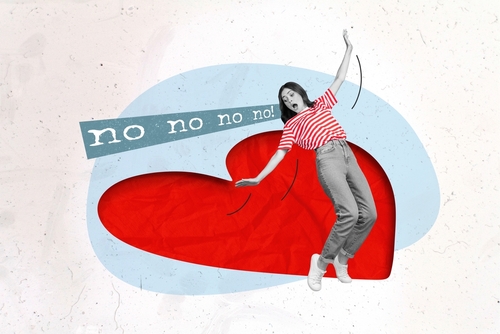For many people, experiencing love is the most beautiful feeling in the world. You may find yourself flooded by emotional responses and eager for the object of your love to be wrapped up in all of the intensity and intimacy of these feelings.
For others, however, love may look very different. It may be more reserved, less vulnerable, even protective. For people with avoidant attachment, it may read to your partners like you have love avoidance, or as though you are simply not able to love as deeply as they are.
The truth is that people with avoidant attachment often desire love, in fact they are often hungry for love. Past experiences, maybe in childhood, maybe related to betrayal or relational trauma, may make somebody feel very cautious and avoidant when they are falling in love and creating commitment. For these people, depth happens slowly, and big, engulfing emotions may feel overwhelming to them.
People with avoidant attachment may experience a real (conscious or unconscious) fear towards intimate connections. This fear can make it seem like these individuals are prone to reject love or connection. However, that’s usually far from the truth. Like all of us, they crave love and yearn for the intimacy that comes from being truly seen and accepted. Deep down, like everyone else, they are eager to hear: “You matter! You’re worth it!”
The challenge for people with avoidant attachment is that past experiences have shaped their ability to experience deep emotional intimacy, and have changed their core they way they approach trust and safety in relationships. This is why it’s helpful for avoidant attachers and the people that love them to really understand this pattern and how it originated. Thankfully, there are ways for these individuals and their loving partners to navigate connection and to build healthy, authentic relationships.
What Is Avoidant Attachment Style?
Avoidant attachment in relationships is best understood when we look at the origin of the concept – Attachment Theory (Bowlby and Ainsworth.) The theory proposes that our early experiences with caregivers shape the way we form emotional bonds and connections later in life.
At Pivot, we also recognize that sometimes events later in life, like a traumatic event, a severe breach of trust, or major life changes can alter the way we attach to others. Because of this, an attachment style can change. For example, a person who has had secure attachment with a partner, and then had an unexpected betrayal trauma, may move into avoidant attachment for some time out of a sense of self-protection.
We also support people to recognize that, although a person may default frequently to one attachment style more than others in intimate relationships, we can show up with different kinds of attachment energy in different situations with different kinds of people. For example, someone who is avoidant with their primary romantic partner may have secure traits with a sibling and anxious traits with an employer. We think of attachment as fluid energy that is dynamically shaped by the nature of the person and circumstances of the relationship.
In general, however, attachment styles are molded by our experiences with our early childhood caregivers. These early relationships become internal working models, influencing how we approach intimacy, trust, and vulnerability as adults. If a child’s needs weren’t met, and they did not experience emotional and/or physical safety in their development, they may have a hard time trusting that others will meet their needs and provide safety throughout their lives. Sometimes over-protectiveness or smothering parental styles can also create avoidant attachment, as adult intimacy may trigger the emotionally engulfed experiences they lived through in childhood.
Avoidant attachment style can feel like love avoidance to their partner because there is some characteristic caution around emotional intimacy. This leads them to process connection, safety and trust, and respond to it in a way that ensures autonomy and protection from the pain that may result from leaving oneself vulnerable.

What Is The Cause Of Love Avoidance?
People with avoidant attachment often had caregivers who were emotionally distant, inconsistent, or dismissive of their needs during infancy and early childhood. Sometimes this might look like overt abuse and neglect. Other times it may be that a parent was unable or unskilled at giving the proper amount of nurturing required for a vulnerable child.
Children who grow up in these environments often learn how to shut down, minimize or neutralize their emotional responses. Maybe they’ve realized that vocalizing and expressing emotional needs does not create any kind of soothing response, or perhaps it even created a negative response that made their emotional distress worse. An example would be a crying toddler who is repeatedly told to “knock it off” or “quit your crying!” or perhaps a slap, spanking, or being placed in isolation followed. The original need – the reason the child was crying – may not be appreciated and tended to. For this child, the lesson is that expressing emotions and seeking emotional support causes more pain.
Over time, this child may adaptively learn that self-reliance is their most successful coping mechanism. This can develop into avoidant attachment in their future relationships. The important thing to realize is that this attachment style developed out of protection, and when it took root, it helped keep this child emotionally safe.
The challenge comes when the emotional avoidance begins to create distance and challenge in the adult relationships that this person cares about. For the avoidantly attached person, it’s often helpful to look at the origin story of their attachment, and create new messages of safety and emotional security, effectively “re-parenting” their inner child. It takes work, but it IS possible to move into secure attachment after a childhood that left someone attaching avoidantly.
When we really look at the way avoidant attachment develops, it’s easy to see why deep vulnerability and emotional depths intuitively feel wrong to this type of person. They may equate this degree of closeness to a loss of independence, a threat to autonomy, or a challenge to their staunch self-reliance… all of which have been protectively effective for them in the past.
This is why avoidants may find themself conflicted when it comes to love. On one hand, they crave emotional closeness and connection. On the other hand, the thought of mutual emotional vulnerability raises their hackles.
How Does Avoidant Attachment Look In Relationships?
Understanding how avoidant attachment affects relationships can prove immensely helpful for both sides involved. For the avoidant, it can be an excellent aid in identifying underlying factors and areas that need addressing. As for those who love someone with an avoidant attachment style, this knowledge can provide a fresh viewpoint. Having empathy and understanding for an avoidant attacher can help their partner approach the relationship in new, healthy ways. Below are some of the most frequent signs of avoidant attachment.
Difficulty Expressing Love and Other Serious Emotions
As we already mentioned, avoidants often find it challenging to express feelings openly. Their discomfort with physical or emotional displays of affection can make their partners feel rejected or unloved, or can leave them feeling conflicted and confused.
It would be a mistake to say that avoidant attachers are always “emotionally unavailable.” Sometimes avoidant partners are available for emotions, but they may be unskilled in expressing and receiving them, or vulnerability may feel unsafe or uncomfortable for them. Rather than emotional unavailability, most avoidant attachers have a limited emotional range, but are available for closeness.
Avoidants may make people feel like they are keeping them at a distance, however, beneath the surface, the avoidant heart might be yearning for closeness. This is the primary reason why walking away from an avoidant should not be a first choice but, rather, a last resort.
A Devotion to the Pursuit Of Independence And Self-Sufficiency
Avoidants value their autonomy and self-sufficiency – this is the trait they adapted into as children when they experienced painful consequences to vulnerability, This often drives them to prioritize personal goals and pursuits (e.g. career, academic achievements, etc.) over the needs of their relationships.
In all relationships, a healthy sense of autonomy and independence is important. For the avoidant attacher, however, it is not intended to develop the unique individuality that benefits the relationship – rather, it feels like an essential survival need and often provides a sense of relief from the emotional demands of the relationship. For this reason, it’s essential for avoidants to strive toward a balance between honoring their independence and nurturing the emotional bond with their partner
Fear Of Commitment
Willingness to commit is the cornerstone of most long-lasting relationships. For avoidants, however, the concept can feel incredibly uncomfortable, triggering anxiety and a sense of entrapment at the mere thought of it.
After all, commitment entails a vulnerability and openness, which normally deepen over time. Vulnerability and openness are two things the avoidant attacher may intuitively feel like stepping back from. Acknowledging and confronting this fear can often be a gateway to forming a deep, healthy connection.
Can Avoidants Be Good Partners?
The answer to this question is never as simple as “yes” or “no”. Like all things in life, it’s much more nuanced than that. In general, the success of the relationship lies in either the avoidant partner’s willingness to grow and adapt to a new dimension of emotional trust and safety, or the partner of the avoidant to adapt their emotional expectations.
Two avoidants who can both agree that a wide swath of personal freedom, limited emotional interdependence, and shallow vulnerability work for them can potentially have a successful relationship, even if it looks different than what social norms might dictate. This type of relationship is uncommon, but it can happen.
On the other hand, an avoidant attacher and an anxious or an ambivalent attacher usually feel quite challenged in understanding and meeting each other’s needs. Ironically, it is not uncommon to find that avoidant and anxious or ambivalent attachers attract each other. In these kinds of circumstances, a mutual commitment for healthy growth and a willingness to shift is usually a necessary part of long-term success.
The truth is that avoidant behaviors (e.g. emotional withdrawal, commitment challenges, etc.), while potentially protective in the past, normally do not benefit adult relationships with emotional maturity. In fact, they can (and often do) derail authentic connection.
The first step toward becoming a better partner as an avoidant is self-awareness. This starts with recognizing that, while your patterns may have kept you safe, they may have also kept you lonely, disconnected or unfulfilled. By recognizing avoidant tendencies and acknowledging harmful behavioral patterns, a person can begin to actively challenge them to “make room” for healthier emotional expression.

PIVOT Helps You Take The First Step Toward Overcoming Avoidant Attachment Style
Whether it is you or your partner who’s trapped in a love avoidance cycle, know that help overcoming avoidant attachments is within your reach. PIVOT is here to provide the support you need to change the way you approach relationships and, in doing so, make yourself open to the genuine connection you deserve.
We can help you take that deep, crucial look at how your early life experiences may have shaped your ability to connect with others in the here-and-now. We will also help you understand how significant adolescent and/or adult experiences like relational trauma, betrayal, grief or other circumstances may have altered your attachment style. When we understand the origin of our patterns, we empower ourselves with greater agency to Pivot out of them and into new, healthier realities.
Join us at our Glass House retreat, where you’ll find a safe space to recover your self esteem and explore the main attachment styles and unravel the emotional barriers that may have held you back. Our experienced team is here to guide you every step of the way, offering personalized coaching sessions that cater to your unique needs and challenges.
Our coaches are here to provide emotional support, teach you about the different adult attachment styles, provide you with healthy mechanisms to develop emotional intimacy, and show you all the benefits of a secure attachment bond in close relationships.
Avoidant attachment is not set in stone nor is it a fixed destiny. It doesn’t have to control your life. So take that courageous first step, reach out to us today, and begin your journey of self-discovery and emotional growth.

